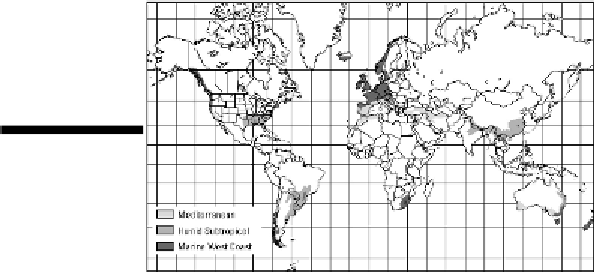Geography Reference
In-Depth Information
Humid
mesothermal
(moderate temperature) climates are located in the low-middle latitudes.
They typically receive more than 20 inches of precipitation per year and therefore are not
“dry.” Also, the coldest month is less than 64° F but above 27° F, which places these climates
between the tropical and polar temperature thresholds (see Figure 10-4). Mild winters and
natural vegetation that is dominated by deciduous trees (which shed their leaves annually, as
opposed to evergreens) are definitive characteristics of these areas, which include the Humid
Subtropical, Mediterranean, and Marine West Coast climates.
Humid subtropical
This climate type is characterized by year-round precipitation, warm summers, and cool winters.
Much of the Southeastern United States is in this category, which helps explain why balmier parts
of that region are favored nowadays by so many people as a desirable place to live and retire. Other
parts of the world that experience this climate include Southern China and the sub-Himalayan lands,
Southeastern South America, and parts of eastern Australia.
Figure 10-4:
The
geography of hu-
mid meso-
thermal climates.
The short winter of this climate-type makes for a long
growing season,
the average number of days
between the last frost of spring and the first frost of fall. As a result, agriculture tends to be an im-
portant activity. In the lower latitudes, where freezing temperatures are rare, citrus and other frost-
sensitive tree crops may be plentiful. But most anything can grow here to good effect. That includes
a majority of the Earth's rice crop (mainly in Asia), arguably the world's most important staple food.
Mediterranean
The principal characteristic of this climate is its dry summer. Though found on all continents, Medi-
terranean climate ismostassociated with—youguessedit—thelandaroundtheMediterranean Sea.
The natural vegetation consists of grasses and scrubs of various sorts, which may become a tinderbox


